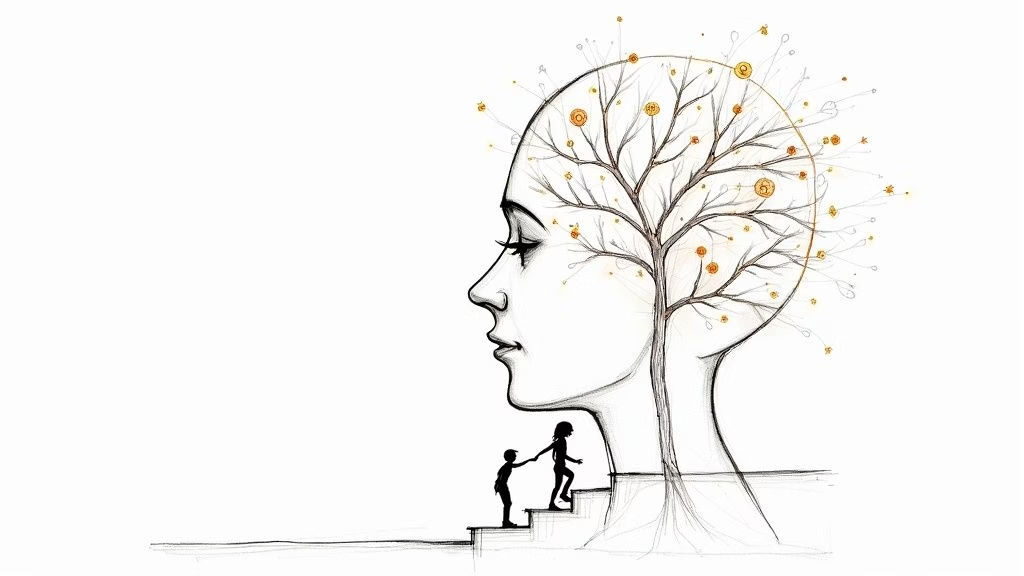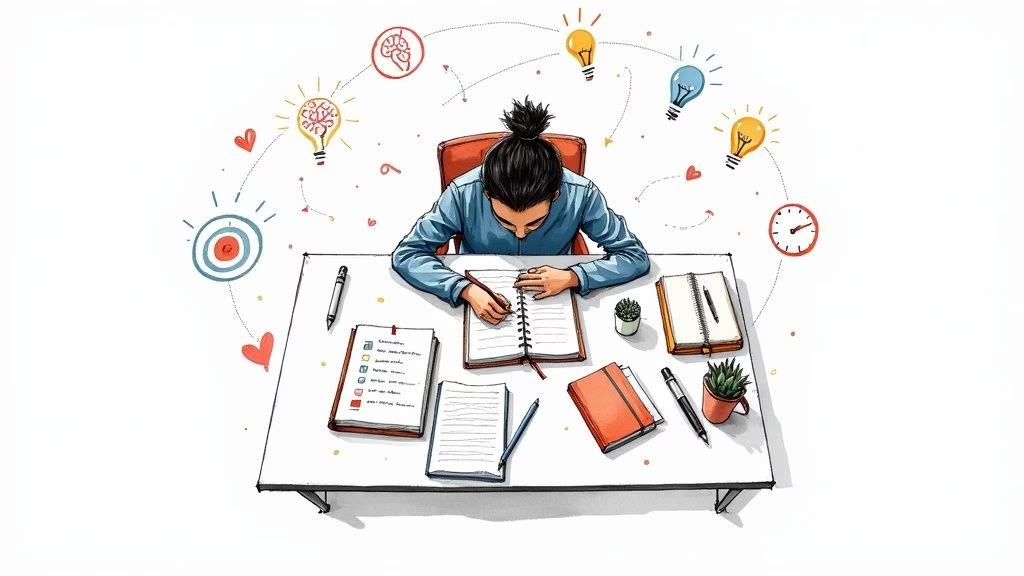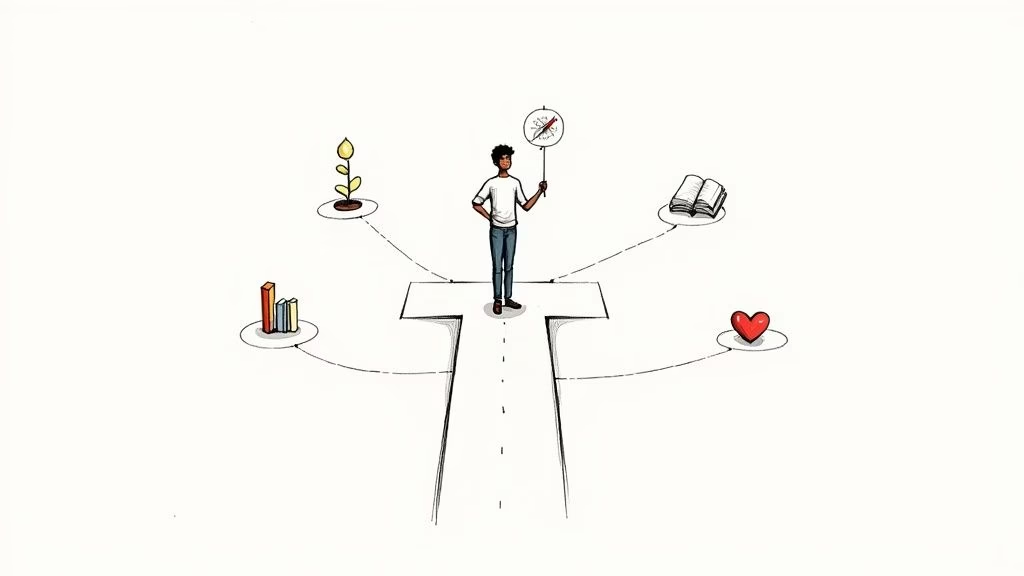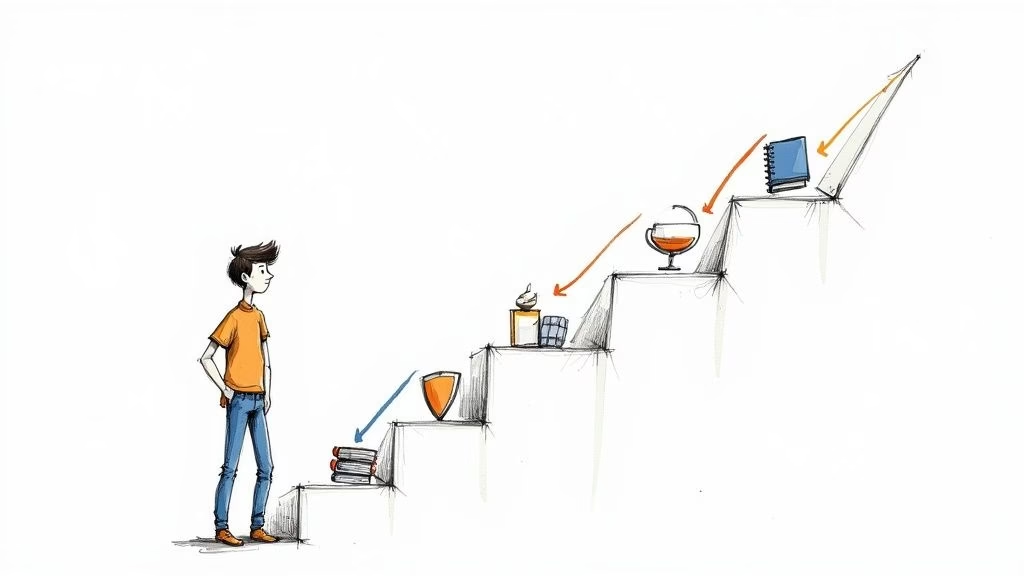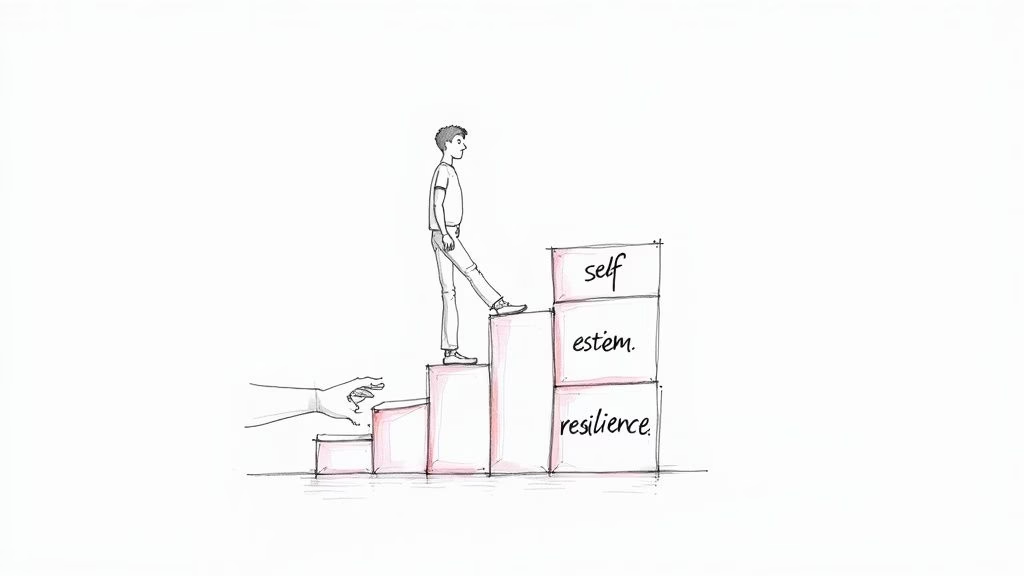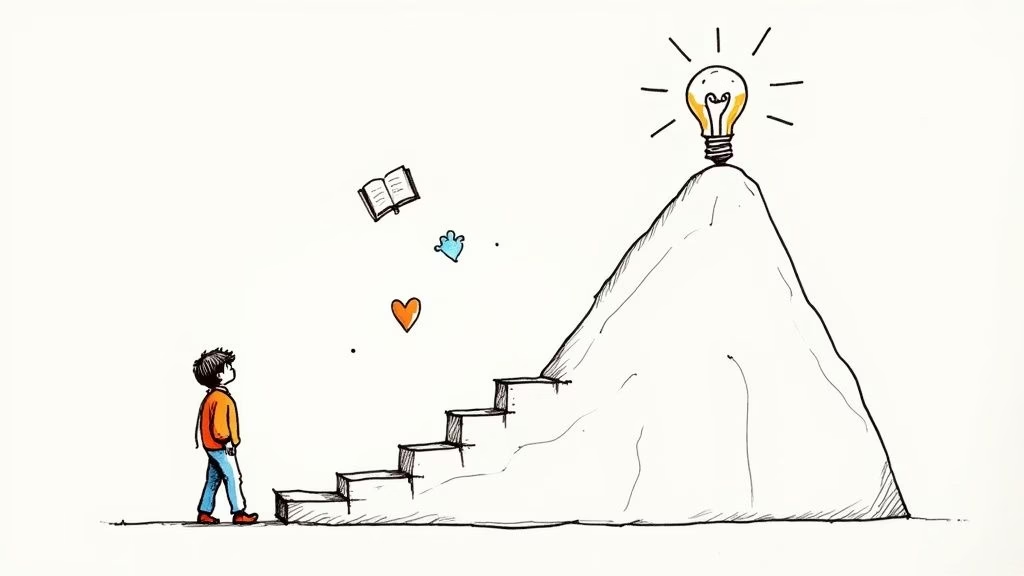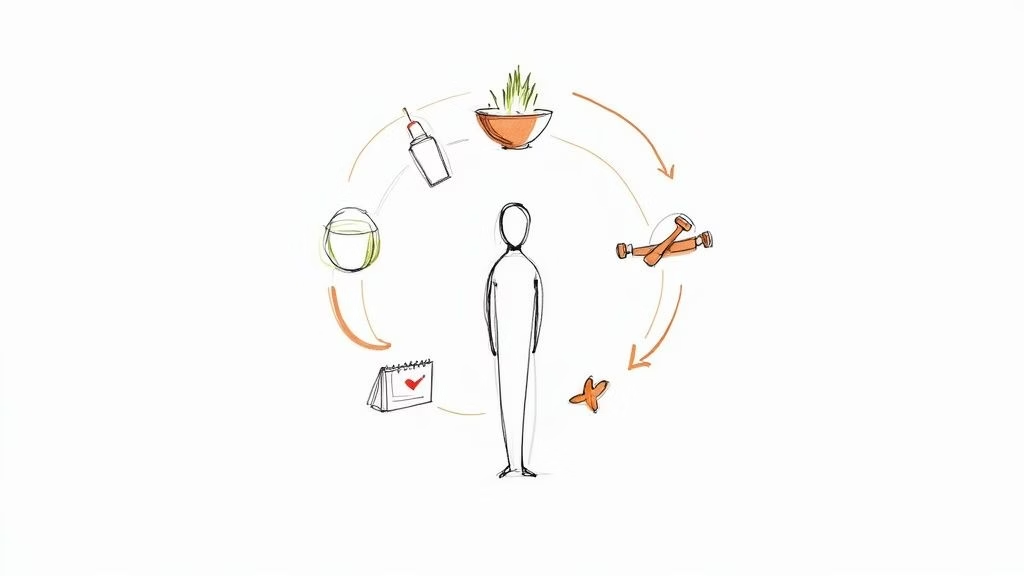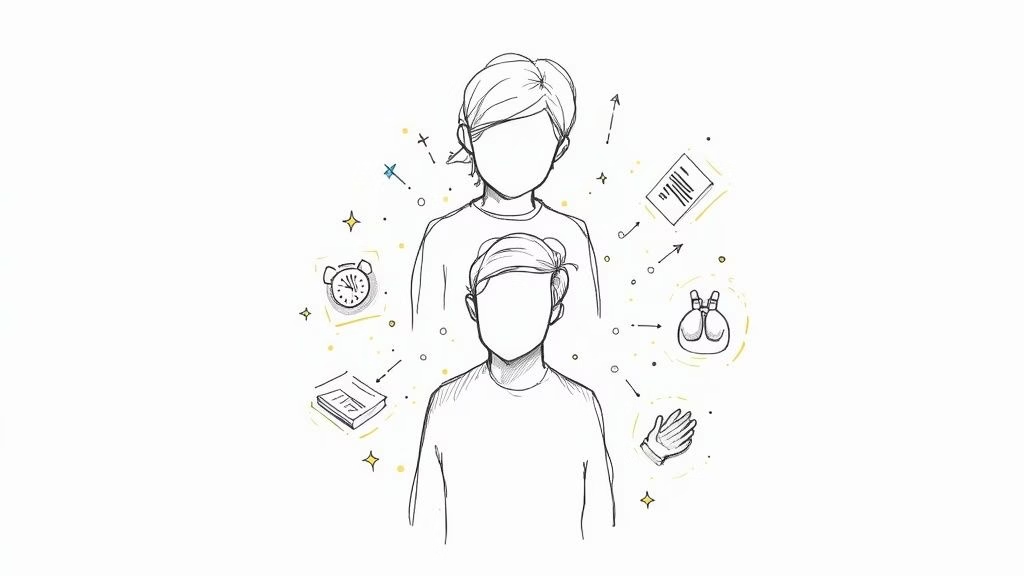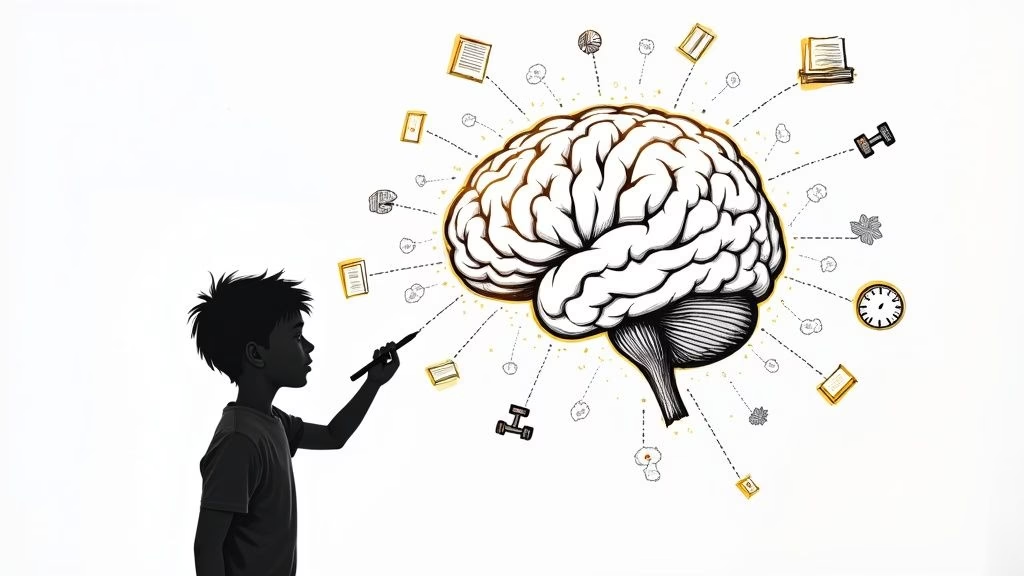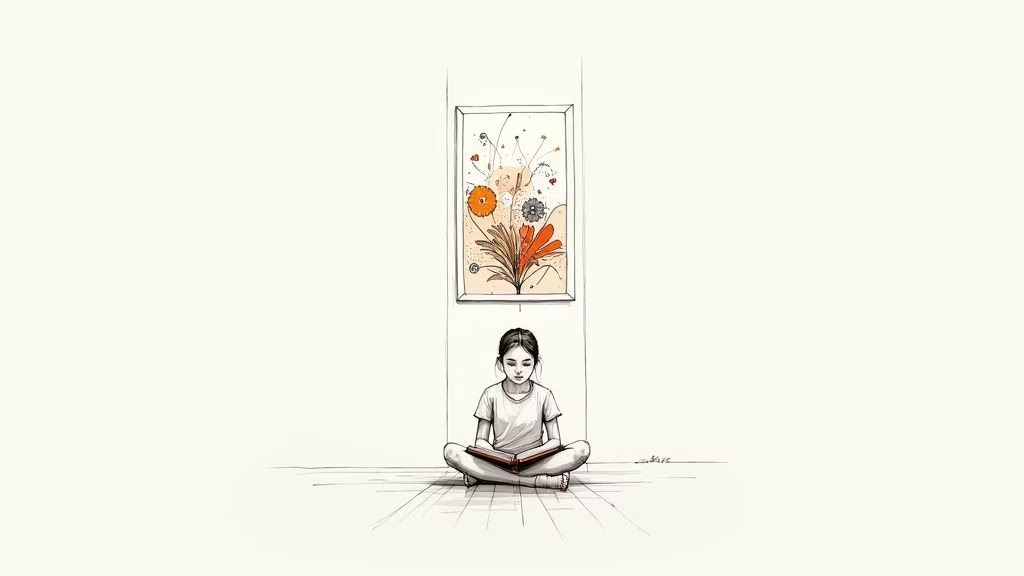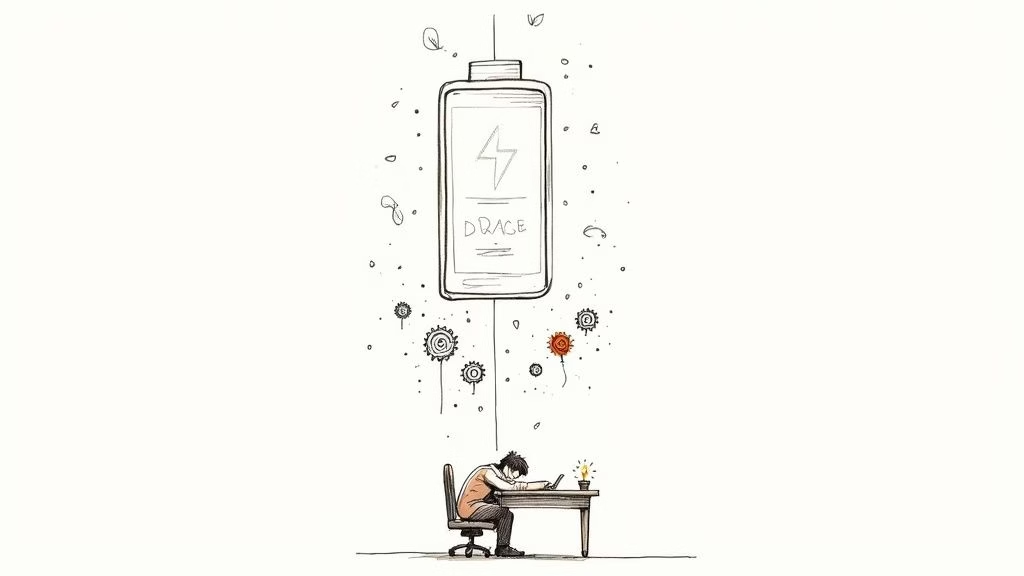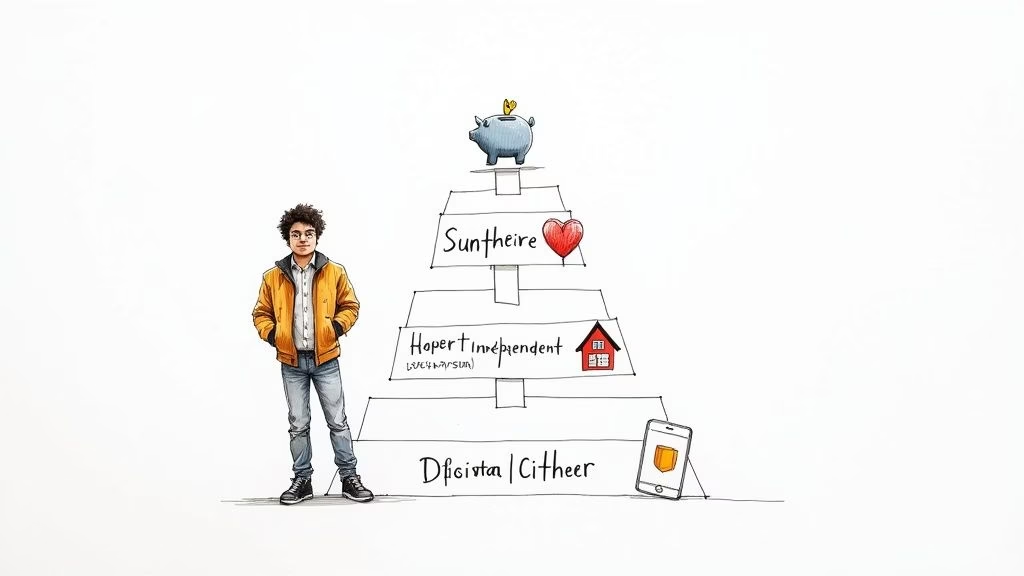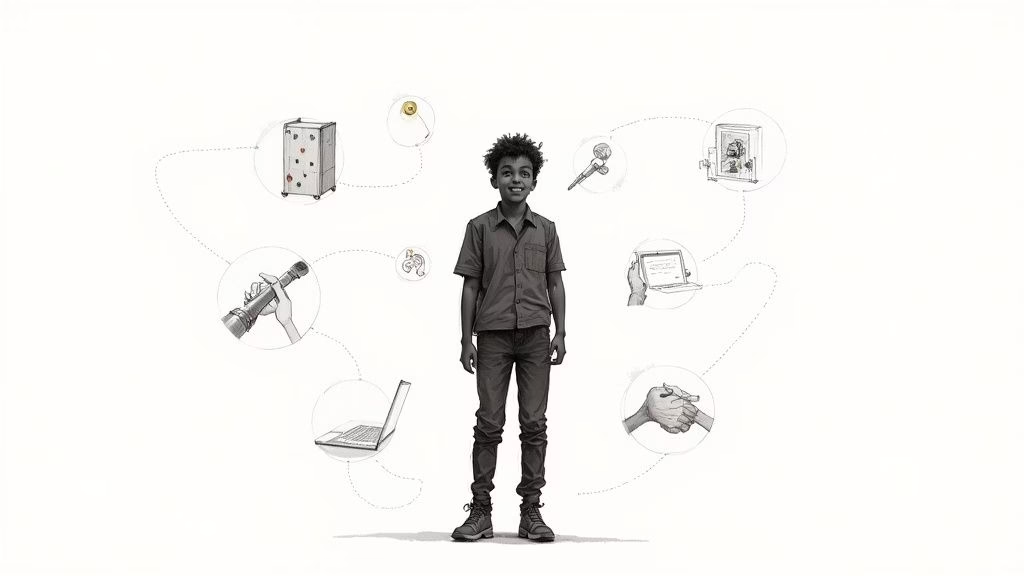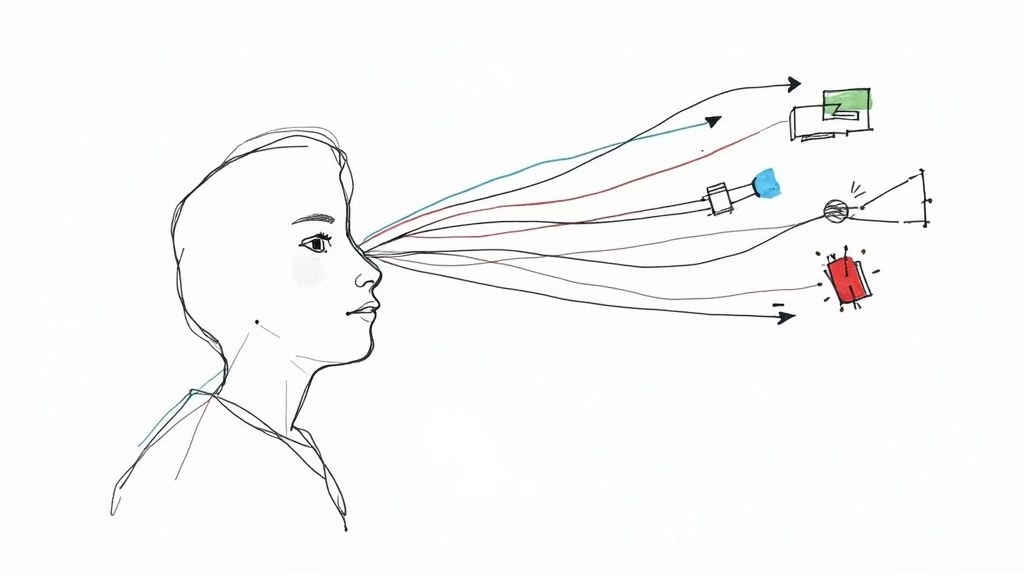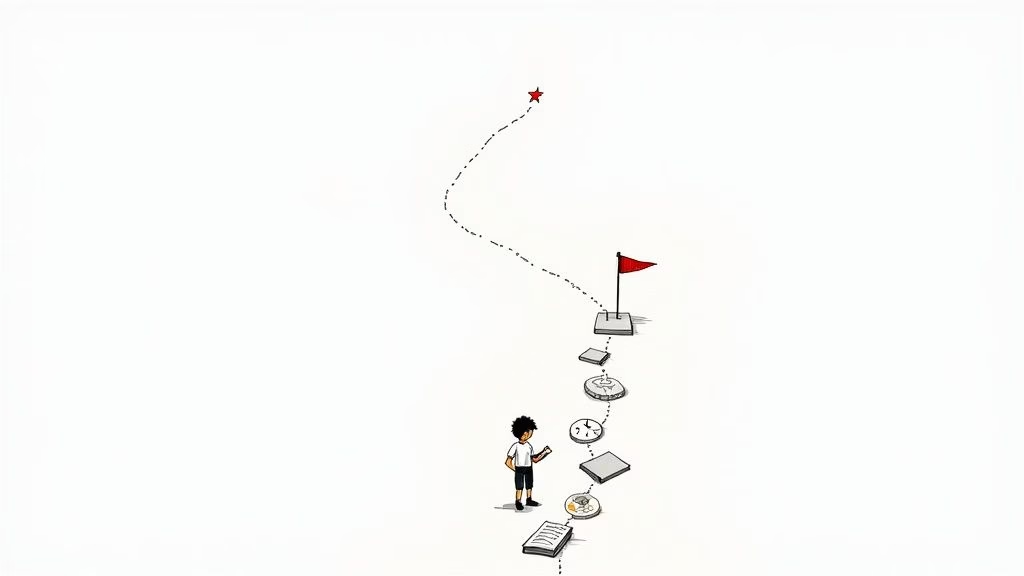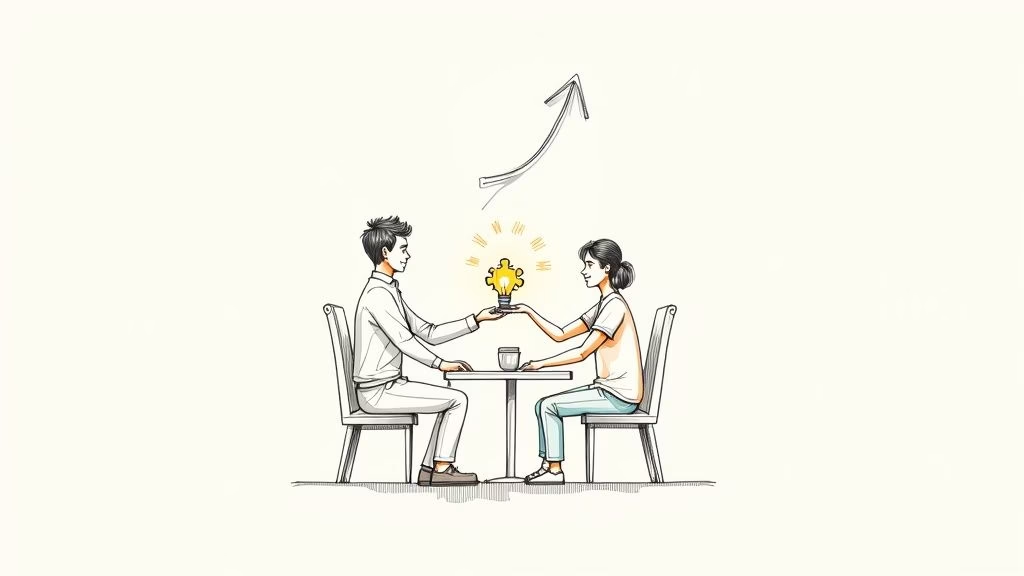A personal development plan is your roadmap for life. Think of it like a GPS for your goals—it shows you where you are, helps you decide where you want to go, and maps out the best way to get there. It’s the tool that turns vague daydreams into a clear, actionable strategy.
What Is Personal Development Planning Really?
Ever tried building a piece of IKEA furniture without the instructions? You might end up with something that vaguely resembles a bookshelf, but it’s probably wobbly and definitely not what you envisioned. A personal development plan is like those instructions for your life—it provides structure, direction, and a clear path forward.
There's a common myth that a Personal Development Plan (PDP) is just some rigid, corporate checklist for climbing the career ladder. But that’s a pretty limited view. In reality, it’s a deeply personal and flexible guide for self-reflection that touches every part of your life—career, education, relationships, and even your mental well-being.
A PDP transforms you from a passive passenger into the active driver of your own life. It's the conscious decision to define your destination and map out the best route to get there, rather than just letting life happen to you.
Beyond the Buzzwords
At its heart, personal development planning is all about intentionality. It’s the simple practice of looking inward to figure out what you truly value, recognizing your strengths, and being honest about the areas you want to improve.
This process makes your ambitions real. If you feel a bit lost defining what actually matters to you, it can be powerful to learn more about personalizing your values and building a life brand.
This shift toward intentional self-improvement isn't just a trend; it's a global movement. The personal development market was valued at around USD 50.42 billion and is expected to keep growing, which shows a massive worldwide focus on investing in our own growth.
Whether you're an adult feeling stuck or a teen trying to figure out what's next, a PDP brings clarity. It pushes you to answer three fundamental questions:
- Where am I now? This requires an honest look at your current skills, habits, and life situation.
- Where do I want to be? This is where you get to dream big and define your long-term vision and short-term goals.
- How will I get there? This is the practical part—creating concrete, actionable steps to close the gap between today and your future.
The Four Core Components of a Personal Development Plan
To make this feel less abstract, let's break down what actually goes into a solid PDP. Think of these as the four essential building blocks. Without them, your plan is just a wish list. With them, it becomes a powerful tool for real change.
| Component | What It Means | Example for a Teenager |
|---|---|---|
| Self-Assessment | Taking an honest inventory of your strengths, weaknesses, values, and current reality. | "I'm great at creative writing but I procrastinate on my math homework. I value helping people, and right now I spend most of my free time on video games." |
| Goal Setting | Defining clear, specific, and measurable outcomes you want to achieve. | "I want to improve my math grade from a C to a B by the end of the semester by studying for 30 minutes every school night." |
| Action Plan | Breaking down your goals into small, manageable steps with deadlines. | "To get a B in math, I will: 1. Ask my teacher for help after class on Tuesdays. 2. Do my homework before playing video games. 3. Find a study partner for exam prep." |
| Review and Reflection | Regularly checking your progress, celebrating wins, and adjusting your plan as needed. | "Every Sunday, I'll review my weekly planner to see if I stuck to my study schedule. If I missed a day, I’ll figure out why and adjust for next week." |
These four pieces work together to create a living document—one that grows and changes with you. It’s not about perfection; it’s about making conscious choices and moving forward, one step at a time.
Why a Personal Plan Is Your Most Powerful Tool for Growth

Knowing what a personal development plan is is the first step. But its real magic clicks into place when you actually put one into action. A plan becomes a catalyst for real growth—it pushes you toward self-awareness, gives you a clear sense of direction, and sparks motivation right when you need it most. To really get it, you have to take charge of your own story, kind of like embracing a 'main character' mindset.
This intentional approach shifts you from being a passenger in your own life to sitting firmly in the driver's seat. You start making proactive choices instead of just reacting to whatever comes your way. And there's a reason this is such a massive industry; things like coaching, workshops, and online learning are part of a market that's expected to hit USD 76.87 billion by 2033. That number points to a huge collective desire to get better—whether it's building leadership skills or just strengthening our own mental well-being.
Overcoming Procrastination and Finding Direction
For a teen, a personal development plan can be an absolute game-changer for beating procrastination. Let's be honest, schoolwork can feel totally disconnected from "real life," which makes it incredibly easy to put off. A plan changes that. It creates a bridge between a small, annoying task—like studying for a history test—and a much bigger, more exciting goal, like getting into a dream college program.
All of a sudden, that boring task has a purpose.
This connection creates a kind of internal motivation that a parent’s nagging just can't replicate. The best thing parents can do is support the process. Help your teen explore what they're genuinely into and frame the plan as a cool project you're tackling together, not just another set of rules to follow. That simple shift builds trust and gives them a real sense of ownership.
Resources and Support for Young Men
A lot of teen boys and young men feel stuck when it comes to finding direction or even just talking about how they feel. A personal development plan offers a private, structured way to explore goals and build confidence without all the pressure. It can also be the first step toward finding other kinds of support.
Here are a few solid starting points for young men and their families:
- Men's groups: Organizations like The ManKind Project create safe, supportive spaces for men to connect and grow with each other.
- Teen mental health info: The Jed Foundation is packed with expert resources on mental health specifically for teens and young adults.
- Teen-focused meditation: Apps like Calm or Headspace offer guided meditations designed to help teens manage stress and sharpen their focus.
When you combine these kinds of resources with a personal plan, you create a powerful support system that helps young men build resilience and navigate the messy, challenging, and awesome parts of growing up.
How to Create Your Personal Development Plan Step by Step
Ready to turn your intentions into real, tangible progress? Building a personal development plan is an incredibly empowering process. Think of it less like a rigid set of rules and more like a custom-made map that guides you toward the life you truly want.
This simple visual breaks down the core journey.

As you can see, it's a climb. You start with knowing yourself, then move step-by-step toward concrete actions and consistent check-ins.
Step 1: Start With Brutal Honesty
Before you can chart a course to a new destination, you have to know exactly where you're starting from. This requires a moment of real, honest self-assessment. A simple SWOT analysis is a fantastic tool for this—it helps you map out your Strengths, Weaknesses, Opportunities, and Threats.
Be real with yourself. What are you genuinely good at? Where do you consistently stumble or feel stuck? Look around you—what opportunities are available (like a supportive mentor or a new class at school)? And what’s standing in your way (like procrastination or that nagging voice of self-doubt)?
Step 2: Define Your Vision
Once you have your starting point pinned down, it's time to decide where you want to go. This is the goal-setting phase, where your dreams start to feel less like wishful thinking and more like a plan. Your vision should be something that truly excites you—something that can pull you forward even when your motivation takes a nosedive.
The key here is to get specific. A vague goal like "get better grades" doesn't give your brain anything to work with. A powerful goal, on the other hand, is concrete and measurable. This is where the SMART framework becomes your best friend, ensuring your goals are Specific, Measurable, Achievable, Relevant, and Time-bound.
If you want to really master this, our guide on how to set SMART goals provides a much deeper dive into creating objectives that actually get results.
For now, here’s a quick look at how the SMART framework can turn a vague wish into a concrete target.
Using the SMART Framework for Personal Goals
A breakdown of the SMART criteria with actionable examples to help you set clear and effective goals.
| Criteria | What It Means | Example Goal |
|---|---|---|
| Specific | Clearly define what you want to achieve. No ambiguity. | "I want to improve my grade in Chemistry." |
| Measurable | How will you track progress? Define clear metrics. | "I want to raise my Chemistry grade from a C to a B." |
| Achievable | Is the goal realistic given your current situation? | "Raising it one letter grade is challenging but doable." |
| Relevant | Why does this goal matter to you? Does it align with your bigger vision? | "A better grade in Chemistry will help my college application for a science major." |
| Time-bound | Set a clear deadline. | "I will achieve this by the end of the current semester." |
Using a framework like this transforms your goals from fuzzy ideas into clear, actionable targets that you can actually start working toward today.
Step 3: Identify Your Resources
Here’s the good news: you’re not starting from scratch. Take a moment to take stock of all the resources you already have at your disposal. This includes your existing skills, the people in your corner (parents, teachers, friends who cheer you on), and any tools that can help, like planning apps or online courses.
Next, figure out what you need. This could be new knowledge, a specific skill you have to learn, or support from someone like a coach or tutor. Knowing where your resource gaps are is just as important as knowing what your strengths are.
Step 4: Build Your Action Plan
This is where the magic happens. You’re going to translate your big, intimidating goals into small, daily actions. An ambitious goal like "get into a competitive college program" can feel completely overwhelming on its own. But when you break it down into tiny, manageable pieces, it suddenly feels doable.
Your action plan might look something like this:
- This Month: Research five potential colleges and list their application requirements.
- This Week: Create an outline for my top-choice school’s application essay.
- Today: Spend 45 minutes studying for my chemistry quiz.
Each small action is a single step forward, building momentum and making it so much harder to procrastinate. Progress starts to feel real.
Step 5: Review and Adapt Your Journey
Finally, remember that your personal development plan isn't carved in stone. It’s a living, breathing guide that should grow and change right alongside you. Schedule regular check-ins to review your progress. A quick weekly review can keep you on track, while a monthly one lets you see the bigger picture.
Life changes, and so will your goals. A successful plan is one that is flexible enough to adapt. Celebrate your wins, learn from your setbacks, and don't be afraid to adjust your course as you grow and learn more about yourself.
A Guide for Teens and Young Adults on Their Path

The jump from teenager to young adult is a wild ride, full of huge questions and what-ifs. A personal development plan isn't about having everything figured out right now—that’s impossible. It's about building a framework to start exploring the answers. It gives you a sense of control when everything else feels up in the air.
For parents, the trick is to treat this like a cool project, not another chore. Frame it as a tool for your teen to discover what they're passionate about and build skills they actually care about. The goal is to shift the conversation from "you should do this" to "I want to do this."
Mental Health and Motivation
This is where personal development planning really shines for teens. It creates a direct line between the boring stuff you have to do today and the awesome life you want to build tomorrow. That connection is a powerful weapon against procrastination.
Suddenly, studying for that math test isn't just about passing a class. It’s a clear, tangible step toward a dream career in game design or engineering. Motivation just clicks into place when you see the "why."
Of course, mental health is the bedrock of any solid plan. We know that teens are dealing with more stress and anxiety than ever. A personal development plan builds resilience by giving you a sense of purpose and breaking down overwhelming goals into small, winnable steps.
Here are a few incredible resources for teen mental health:
- The Jed Foundation: A top-tier nonprofit that gives teens and young adults the skills and support to handle emotional challenges.
- Teen Mental Health.org: This site offers easy-to-understand, science-backed info on all sorts of mental health topics, written specifically for young people.
- Anxiety Canada: They provide awesome, evidence-based tools for free, including the MindShift CBT app, which helps you learn to manage anxiety.
A personal development plan is a proactive mental wellness tool. It flips the script from just reacting to stress to actively building a life that feels authentic to you. It's about taking back a sense of control and hope.
A Simple Meditation Guide for Teens
Meditation is one of the best tools for dialing down stress, sharpening your focus, and getting clear on what you want—all essential for planning your next moves. You don’t need a fancy cushion or a silent retreat. All you need is five minutes and a quiet corner.
Give this simple mindfulness exercise a shot:
- Find a comfortable spot. Sit on a chair with your feet on the floor, or cross-legged on the ground. Just be comfortable and upright.
- Gently close your eyes. Take a big, slow breath in through your nose, and let it all out through your mouth.
- Focus on your breath. Just notice the feeling of the air coming in and going out. Feel your chest or stomach rise and fall. That’s it.
- Your mind will wander. It’s supposed to. When you notice you’re thinking about something else, just gently guide your focus back to your breath. No big deal.
- Keep going for 3-5 minutes. When you're done, slowly open your eyes and just sit for a moment, noticing how you feel.
Doing this daily can literally train your brain to be calmer and more focused, which makes tackling your goals way easier. There are tons of other techniques out there, and you can explore more of them in our guide to personal growth activities.
Resources for Teen Boys and Young Men
For a lot of guys, the pressure to have it all figured out is intense. It can make talking about struggles or asking for help feel almost impossible. That’s why normalizing self-improvement is so important. A personal development plan offers a structured, private way to set goals and build real confidence on your own terms.
Finding a supportive community can also be a game-changer. Groups that encourage positive masculinity and real, honest conversations create a space where young men can grow without feeling judged.
Check out these resources:
- The ManKind Project: This group runs programs that help men live with more integrity, accountability, and connection.
- EVRYMAN: An organization dedicated to helping men connect with their emotions and each other through online groups and retreats.
- Local Mentorship Programs: Look for community centers or local groups that can connect you with a positive adult role model.
These aren't about fixing something that's broken. They're about tearing down the old myth that asking for help is a sign of weakness. True strength comes from knowing yourself and having the courage to grow.
The Right Tools for the Journey
A good plan is one thing, but having the right support makes all the difference. Think of these resources as your support crew—they're the ones who hand you the right gear, offer a map when you're lost, and cheer you on when the path gets steep.
It’s no surprise that more people are focusing on self-improvement. The global personal development industry is on track to hit USD 68.42 billion, growing at 6.1% each year. That boom is driven by new tech and a bigger focus on building skills and taking care of our well-being. You can dig into the numbers in this market analysis report.
For Teens Needing Focus and Mental Clarity
For teens juggling school, friendships, and everything in between, mental wellness tools aren't just a nice-to-have; they're essential. Procrastination and a lack of motivation often aren't about laziness—they're signs of stress or anxiety bubbling under the surface. Building a toolbox to handle those feelings is a huge part of any solid development plan.
- Meditation Apps: Tools like Calm or Headspace have guided meditations made just for teens. Even a five-minute session can dial down stress, sharpen focus before hitting the books, and help manage emotions that feel too big to handle.
- Mental Health Resources: Websites like The Jed Foundation and Teen Mental Health.org offer reliable, straight-to-the-point info on anxiety, depression, and how to build resilience. They’re fantastic for both teens and parents who want to understand this stuff better.
- A Tip for Parents: Don't present these tools as a "fix." Frame it as a mental "gym." They're training their brain, just like they’d train for a sport.
The goal isn't to get rid of stress—it's to build the skills to move through it. These resources give teens the power to understand what's going on inside and take steps to feel better, which is the foundation for chasing any goal.
For Young Men Looking for Direction
Young men often deal with a unique set of pressures and can find it hard to find places where they can talk openly about their goals and struggles. A personal development plan can be a private roadmap for growth, but connecting with a supportive community can make the journey feel a lot less lonely.
- Men's Groups: Organizations like EVRYMAN and The ManKind Project create structured spaces for young men to connect with guys their age and find positive mentors. The focus is on emotional intelligence and accountability—skills that are critical for life.
- Skill-Building Platforms: Websites like Coursera or Khan Academy offer free or cheap courses on just about anything, from coding to public speaking. They’re a great way for young men to explore what they're into and build real skills that boost their confidence.
- A Tip for Parents: Encourage them to explore without judgment. If your son shows interest in a group or wants to try learning a new skill, back him up. It reinforces that working on yourself is a sign of strength.
And to help turn those big goals into small, daily actions, practical tools like work-life balance guides and checklists can be a game-changer. They help bridge the gap between where you are and where you want to be, making the whole process feel much more manageable.
Got Questions About Personal Development Planning?
Starting a personal development journey is exciting, but it's totally normal for questions to pop up. This is a process of getting to know yourself better, and you don't need to have all the answers right away. Let's tackle some of the most common ones so you can feel confident starting your plan and actually sticking with it.
How Often Should I Review My Plan?
Think of your personal development plan as a living, breathing document—not a stone tablet you carve once and forget about. A quick weekly check-in is perfect for tracking your smaller actions and keeping the momentum going. It's like a quick huddle with yourself to see how you're doing.
For the bigger picture, a deeper review every three months is the sweet spot.
This quarterly check-in is your chance to celebrate wins, figure out what's working (and what's not), and tweak your larger goals if needed. Life changes, and your plan should be flexible enough to roll with the punches.
What if I Feel Unmotivated?
Let's be real: motivation isn't a constant. It comes and goes like a wave. When you feel it dip, the best thing you can do is reconnect with your "why." Remind yourself why you set these goals in the first place—what's the exciting, meaningful vision you're working toward?
If a goal feels way too big, smash it into smaller, almost laughably easy steps. And when you hit a setback, don't see it as a failure. See it as feedback. What happened? What can you learn? How can you adjust your approach? It's all part of the game.
"A goal without a plan is just a wish." – Antoine de Saint-Exupéry
This quote nails it. A plan is what turns your dreams into something you can actually do, giving you a clear path to follow even on the days you'd rather stay in bed.
Can This Really Help with School Procrastination?
Absolutely. Procrastination usually comes from one of two places: feeling disconnected from a task or feeling completely overwhelmed by it. A PDP is your secret weapon against both. It creates a direct line between the boring daily stuff (like "read chapter 4") and a much bigger, more inspiring vision (like "get into my dream college to study computer science").
That connection gives otherwise tedious tasks a real purpose, making studying feel a lot more meaningful. It gives teens a solid reason to get started now, which is way more powerful than just feeling pressured.
For parents, the best thing you can do is help foster this connection. Help your teen dig into their interests and frame the plan as a cool adventure you're on together, not just another chore. If they're struggling, you can work together to find helpful resources like The Jed Foundation, which offers fantastic mental health support for teens, or even introduce a simple meditation guide to help them manage stress and find their focus.
What About Resources for Young Men?
A lot of young men and teen boys feel this insane pressure to have everything figured out, which can make it hard to ask for help. A personal development plan can be a great first step—it’s a structured, private way to start building confidence on your own terms.
But pairing that with community support? That's where the real magic happens.
Resources like The ManKind Project and other men's groups create safe, supportive spaces for young men to connect and grow. These communities show that the journey of self-improvement isn't something to hide. In fact, they prove that true strength lies in having the courage to work on yourself and lift others up along the way.
At Andrew Petrillo Life Coaching, I specialize in helping teens and young adults build the clarity and confidence they need to stop drifting and start thriving. If your teen is struggling with motivation, procrastination, or just figuring out their next steps, my one-on-one coaching provides the personalized roadmap they need to succeed. Book a complimentary discovery call today to learn more at https://andrewpetrillolifecoaching.com.


